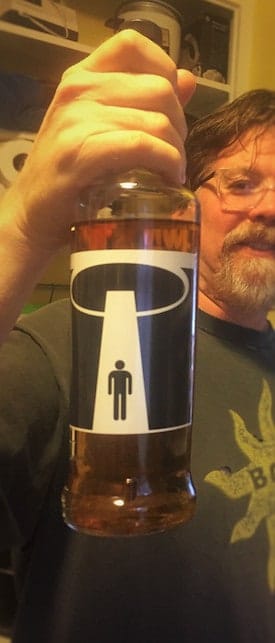
Creating your own whisky blends can be a real kick. When perfected through patience and experience, the knack of skillfully crafting a unique whisky vatting can become a hobby in its own right.
Knowing how to blend whiskies is always a good skill to have, particularly if there’s a flat one in your cabinet, with only a few fingers left in the bottle, which has passed its prime. In such cases, never pour out the semi-lifeless spirit unless it’s completely given up the ghost. Often, all that it needs is a bit of perking up with something fresh. Sometimes, that older “flat” whisky is really good stuff, and in such cases vatting the flat stuff with a younger, perkier whisky is just what the doctor ordered.
I tend to use the word “vatting” for the process of blending different whiskies together. A “single malt blend” is technically made from different casks of malted barley whisky from a single distillery. And so, I cannot claim that title for my vattings. Rather, I call them “Whisky Kirk Blends,” even though I use only single malts Scotches, often from different distilleries, as my ingredients.
Like famous blends from a company such as Compass Box, personal vattings can be an art form. Don’t sell yourself short. You might have a knack for making some good blends. Just remember that’s it’s usually best to let your blends co-mingle in the bottle for up to a fortnight (two weeks) or longer before drinking them.
Yes, it can be fun to take an active role in what you and your guests drink. And if you happen to hit upon a tasty blend that you have made yourself, this “hands-on” creation can taste pretty darned pretty impressive to friends, family, and coworkers. You will feel an especially rewarding sense of satisfaction if you’ve killed two birds with one stone, by also saving a dying whisky.
The finer points of DIY vatting
But if you decide to start with two fresh whiskies, that’s fun, as well. I recommend using two-thirds low-cost whisky, along with one third of something a bit more special that makes the whisky vatting shine. This ratio for a vatting can work quite well at larger parties, which can be quite expensive to stock with a yummy tasting whisky for the sake of sipping (not for mixing with sodas).
Vatted whisky in reused fancy bottles can really look festive at a large gathering, as well as tasting really good for a wide range of tastes. Whatever the occasion happens to be, other folks needn’t be appraised of the fact that your two thirds whisky vatting is “cost effective,” so to speak (cheap at the cash register). In other words, there’s no need to volunteer the information.
Oftentimes, less is more. Just as a magician guards his magic trick, there’s no need to give away your private recipe (unless you are directly asked). A sense of mystery is part of the charm, especially if the reasonably priced whisky in your blend doesn’t happen to be a big fancy-schmancy name.
Be this as it may, do be sure to tell folks that the whisky they are drinking is a blend you made yourself. It’s very bad form to put a vatting in a bottle with a fancy label, in the attempt to pass it off as the expensive whisky. And how embarrassing it would be for you, if an experienced whisky drinker happened to call your bluff!
A few years back, I really liked blending an “off label” Glenfarclas 9 Year Old as two thirds of my VSB (very special blend). After I’d poured the young Farc into a freshly washed bottle, sometimes with my own personal vatting label added to it, the whisky could either be dressed up as a “sweetie,” or dressed down as a “peatie,” depending upon the other third of the blend.
In such cases, Glenfarclas 105 or Aberlour A’bundadh worked wonders as the one third sweetie, as did an Ardbeg 10 Year Old or Talisker 10 Year Old as the one-third peatie.
A nice budget “peater” that sells in Oregon for under $35 is Bowmore Small Batch. If you really want to save money, then McClelland’s Islay is dirt cheap in many parts of the world, owing to the fact that it’s actually a young, and somewhat “dirty,” Bowmore.
Of course, the same principles can be applied to vatting with bourbons, or world whiskies. But that is, perhaps, an apt topic for yet another article. . . .
When I first became interested in concocting what eventually evolved into my “Magickal Mystery Blends,” it helped that I’d found a real gem for the two-third component, which blended like a sergeant. Ah, the good ole days. I remembering being able to snag a bottle of the off-label Glenfarclas 9 Year Old for a mere $22! How’s that for a bargain? It’s been years since I’ve seen that diamond-in-the-rough on store shelves.
At parties, Whisky Kirk’s Magickal Mystery Blend is always a hit among whisky drinkers, especially when it arrives in a big oval Signatory Vintage bottle, or some other fancy recycled bottle. Hibiki whisky comes in a very attractive bottle, indeed, which can be washed out, and used, over and over again, as a beautiful carafe.
Happy vatting, you magickally mysterious maltsters!








